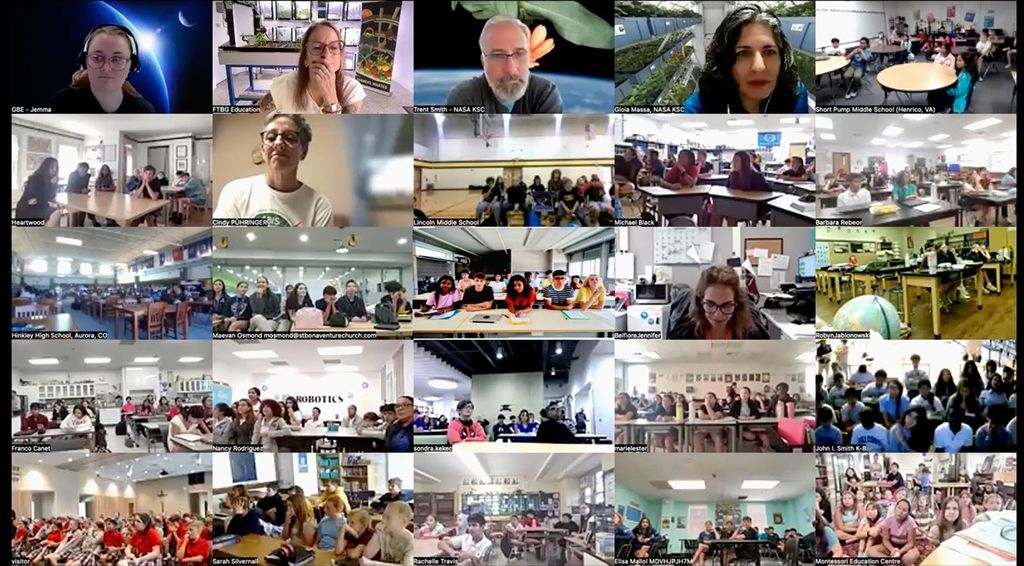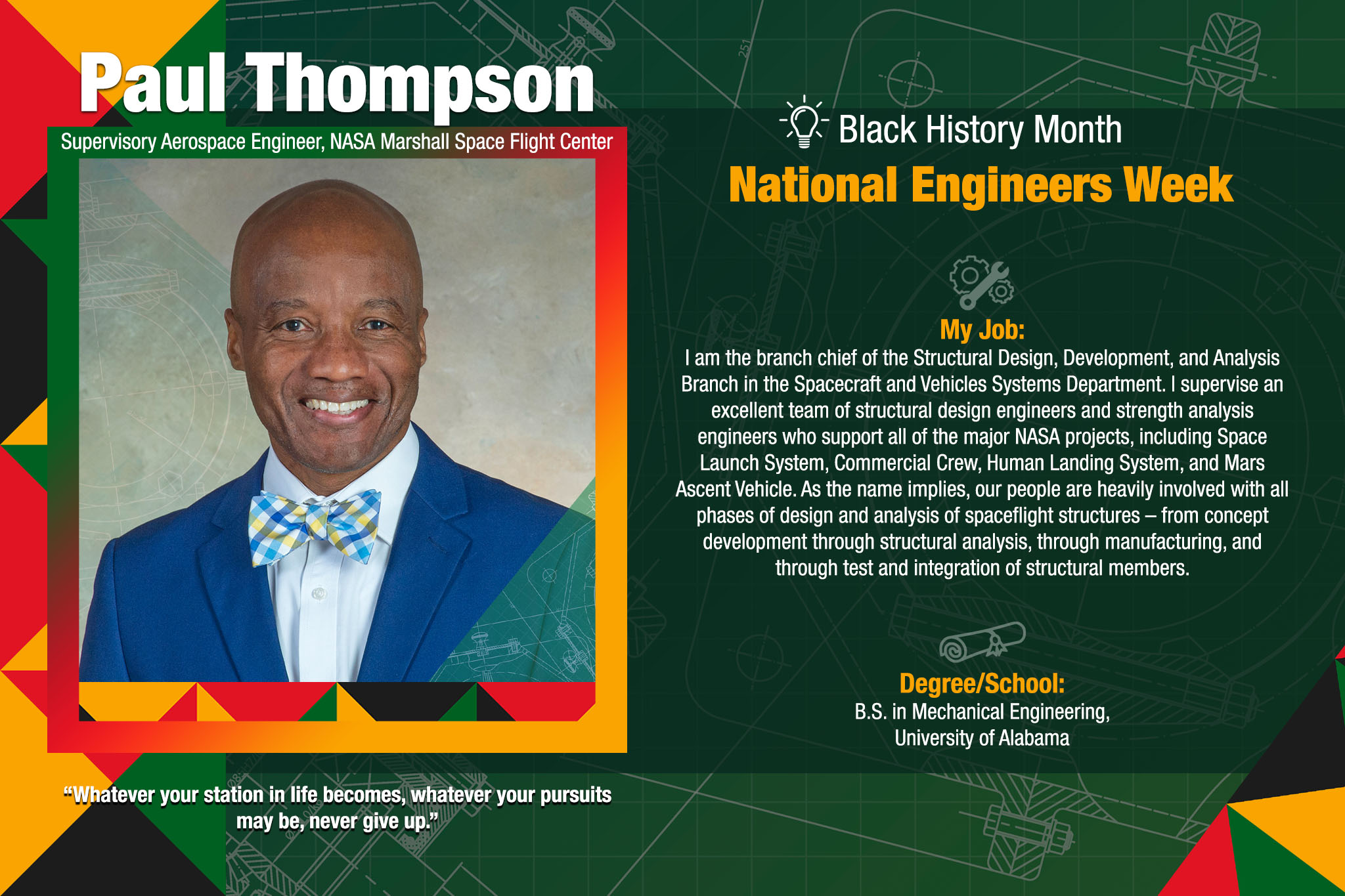Paul Thompson is a supervisory aerospace engineer with a Bachelor of Science degree in mechanical engineering from University of Alabama in Huntsville and has worked NASA Marshall Space Flight Center for more than 35 years.
What is your job and how do you support the NASA mission?
I am the branch chief of the Structural Design, Development, and Analysis Branch in the Spacecraft and Vehicles Systems Department. I supervise an excellent team of structural design engineers and strength analysis engineers who support all of the major NASA projects, including Space Launch System, Commercial Crew, Human Landing System, and Mars Ascent Vehicle. As the name implies, our people are heavily involved with all phases of design and analysis of spaceflight structures – from concept development through structural analysis, through manufacturing, and through test and integration of structural members.
Who or what inspired you to choose your career and why?
My mother was my main inspiration for me, period. I’m one of seven kids. Though she didn’t graduate high school, she went back and got her GED when I was in fifth grade and became a nurse in less than two years in her mid-thirties. To see her succeed, to not give up on becoming the best she could be, helped me tremendously in getting to where I am today.
Growing up in a rural area, I never heard the words “aerospace engineer.” In high school, however, because of my math aptitude, one of my teachers and I talked a lot about engineering as a profession. I really didn’t meet a black engineer until after high school. A high school friend’s dad saw me working at a restaurant the summer after graduation. Because the dad knew of me, he arranged for me to apply for an internship program with the Tennessee Valley Authority to work with design and environmental engineers. I had always been fascinated by dams, bridges, and buildings, and other civil engineering type duties, and interned with TVA throughout my college years.
During that internship, I was persuaded by my mentor to look into mechanical engineering as a major because of all the various possibilities that field offers. Taking that advice, I changed my major from civil to mechanical engineering. Also, at University of Alabama in Huntsville, many of my classmates had parents who worked for NASA, and they were talking about things like the future Space Station and the new rockets being built. That sounded interesting to me, so I applied for employment with NASA my senior year and here I am.
What do you find most rewarding about being an engineer with NASA?
It’s most rewarding interfacing/knowing the great number of really smart people with NASA. In college, I gained an appreciation of how we actually got man to the Moon, and for the great number of really intelligent people who contributed to that task. Now, I get to interface daily with a set of folks that are just as sharp.
What do you find most challenging about your job?
As branch chief, I am concerned about a “laundry list” of activities. The most challenging part is keeping up with all the things that must get done. That’s also one of the most rewarding because almost every day there is a different challenge that requires attention.
From your experience, what do you feel are the most important qualities a leader should have to be successful?
Compassion is number one for me, showing people you care about them as a person and not just for their technical abilities. Earning trust is a derivative of showing that compassion. The ability to make decisions is also important.
What’s the most important risk you took and why?
Remaining in the same organization my entire career was risky. I like what our branch does, and I have since day one. As time passed, and other opportunities were presented, I knew that I wanted to be in a position to lead and possibly influence someone’s career path. First, being team lead, then, deputy branch chief, and now chief, these positions have all given me just that.
As a leader, how do you keep your team motivated, especially when there is conflict or obstacles?
As cliché as it may sound, maintaining positivity is the key. Because of the demographics of who I am, I feel I am qualified to say that you are being watched by someone at all times. To display a good attitude is of paramount importance. Project positivity as much as possible, even on your bad days, even when the bridge is falling down, consider it an opportunity to go for a swim.
What do you enjoy doing outside of work?
Watching and participating in sports are major outlets/hobbies for me. I enjoy running, lifting weights, keeping fit. Trivia game shows also pique my interest.
Do you think diversity and inclusion are important for NASA to achieve success?
Diversity and inclusion are essential if NASA is to continue thriving and holding its rank as the best place in government to work. As I said previously, each day I get to work with some of the most intelligent people around. These people are sometimes of various ethnicities, backgrounds, cultures, etc. The common ground is that they are all thinkers, problem solvers, and adventurers. That is NASA; it’s what we do.
Including even more backgrounds, life experiences, and the like, broadens that spectrum of possible solutions. We don’t all see things from the same lens. A highly motivated, diverse workforce will bring more fruit. When people realize and see the results of giving similar opportunities to all, regardless of background, ethnicity, and culture, NASA will continue to shine.
In February, we celebrate Black History Month. Who has inspired you the most in Black history and why?
The “safe” answer is people that are known on the world-wide stage, like Dr. Martin Luther King, Jr., Frederick Douglas, Sojourner Truth, Harriet Tubman, Jackie Robinson, Barack Obama, and the litany of others that can be found on the Internet or in textbooks. However, there is a class of individuals, a class of unsung heroes that are only known by a smaller audience, that have made the Black experience the powerful force it is today and have made a way for so many others like me. That class of individuals is the Black community.
An African proverb states that “it takes a village to raise a child.” The village is what inspires me. It helped Martin, Barack, Rosa, Kamala, Oprah, Angelia Walker, Dawn Stanley, Tawnya Laughinghouse, me, and countless other Black Americans get to where we are today.
That black sharecropper whose harvest was distributed freely by brown paper bags and burlap sacks to the elderly, single mothers, and less fortunate in the community; the preacher whose salary might only be enough for gas money but was there for the counseling and consoling of the community; that grandmother who raised her grandkids while the parents worked in the factories to put food on the table; and the maid who cleaned houses day and night to afford to send her children to college are all inspirations to me.
Sure, the leaders we read about deserve their just rewards for leading. I have the utmost respect and admiration for them, but the village is the key to long term sustainability and progress. The work ethic, resilience, perseverance, and care for others exhibited by the villagers have always been a source of inspiration.
There are times when we all get a bit discouraged, especially when our truth is that we are being treated unfairly. It is in those moments that we have to turn to a Higher Strength; it is in those moments that we have to muster up that extra effort. Perseverance is the key! None of those courageous, recognized leaders in the Black community gave up – not MLK, not Rosa, not Medgar Evers. They all persevered. Whatever your station in life becomes, whatever your pursuits may be, never give up.
What advice would you give young people who might be interested in pursuing a career in STEM (science, technology, engineering, and math)?
My advice would be to pursue that interest. Not all, if any, of it will come easy; you have to give it your best effort. Your village will help you.





























